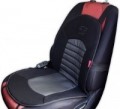Heating element
The type of heating element used in the device.
-
Wire. A heating element in the form of a high-resistance alloy wire that generates heat when an electric current is passed through. Such heaters are relatively inexpensive, while they heat up quickly and retain heat for some time after switching on. On the other hand, wire is stiffer than carbon fibre and can be uncomfortable, and is also considered less reliable.
-
Carbon fibre. Heating elements based on carbon fibre are considered more durable and convenient than wire ones. Among other things, they are softer and do not stand out as much under the shell of the heating element; in addition, carbon fibre is more resistant to bending and folding. The disadvantages of this option are, firstly, a rather high cost, and secondly, a slightly lower heating rate.
Heating control
The ability
to adjust the degree of heatingprovided by the device. This function allows you to adjust the operating mode according to user preferences and specific situations. For example, in a car that has not been warmed up since the night, it is best to turn on the “heating of the seat” to the full, and if the car has not stood for a long time and has not had time to cool down, the maximum heating intensity may not be needed.
Power
Power consumption of the device. When choosing, this parameter often has an exclusively reference value: the energy consumption of heating systems is not so high as to cause problems when connected to the on-board network, and the specific heater power is selected by the manufacturer in such a way that the device is able to effectively perform its functions.

